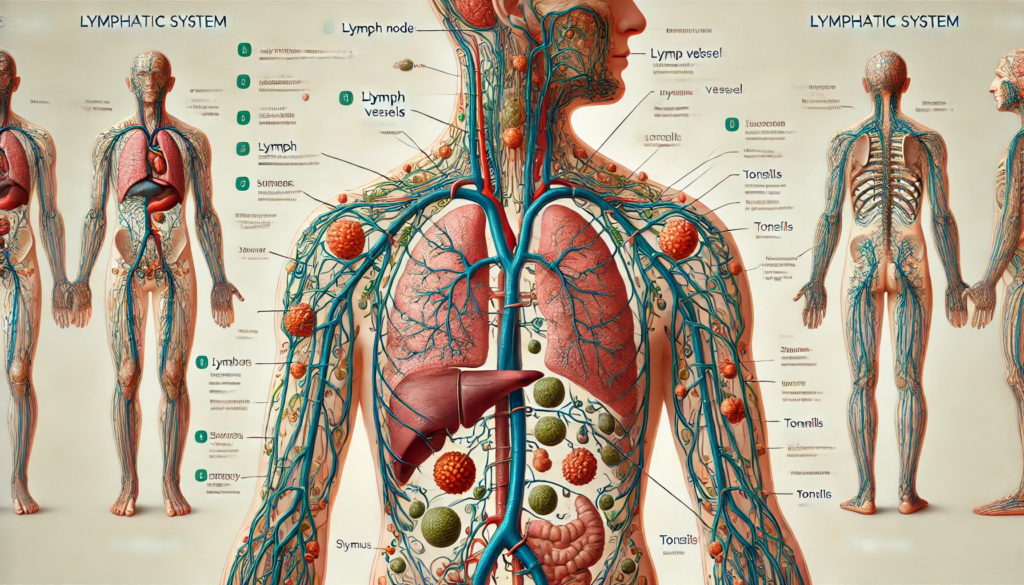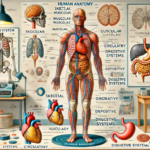The lymphatic system is an essential component of the human body, playing a critical role in immune defense and fluid balance. It is a complex network of vessels, tissues, and organs that work together to transport lymph, a fluid containing white blood cells, throughout the body. This article provides a comprehensive overview of the anatomy and functions of the lymphatic system, including the lymph nodes, lymph vessels, and other key structures involved in maintaining health.
Anatomy of the Lymphatic System
The lymphatic system is comprised of various components that collectively perform crucial functions for the immune system and fluid regulation. The main components include lymphatic vessels, lymph nodes, lymphatic organs, and lymphatic fluid.
1. Lymphatic Vessels
Lymphatic vessels are a network of thin tubes that run parallel to the body’s veins. They transport lymph, a clear fluid that contains immune cells, waste products, and other substances. The vessels are similar in structure to blood vessels and are classified into:
- Lymph Capillaries: These are tiny, blind-ended tubes found in the tissues throughout the body. They absorb excess interstitial fluid (fluid between cells) and transport it into larger lymphatic vessels.
- Larger Lymphatic Vessels: These vessels are similar to veins and have one-way valves that prevent the backflow of lymph. They transport lymph toward the lymph nodes and eventually to the lymphatic ducts.
- Lymphatic Ducts: The two main ducts are the thoracic duct and the right lymphatic duct. The thoracic duct drains lymph from most of the body into the left subclavian vein, while the right lymphatic duct drains lymph from the right upper limb, head, and neck into the right subclavian vein.
2. Lymph Nodes
Lymph nodes are small, bean-shaped structures located along the lymphatic vessels. They act as filters for lymph, trapping foreign particles, bacteria, and cancer cells. Lymph nodes contain lymphocytes (white blood cells) that help initiate an immune response. They are clustered in various regions of the body, including:
- Cervical Lymph Nodes: Located in the neck, they filter lymph from the head and neck.
- Axillary Lymph Nodes: Found in the armpits, they filter lymph from the upper limbs and chest.
- Inguinal Lymph Nodes: Located in the groin, they filter lymph from the lower limbs and genitalia.
- Abdominal Lymph Nodes: Found in the abdominal cavity, they filter lymph from the digestive organs.
3. Lymphatic Organs
In addition to lymph nodes, the lymphatic system includes several organs that play vital roles in immune function:
- Spleen: The largest lymphatic organ, located in the upper left abdomen. The spleen filters blood, removes old or damaged red blood cells, and helps fight infections by producing lymphocytes.
- Thymus: A small organ located in the chest, just above the heart. The thymus is crucial for the development and maturation of T-lymphocytes (T-cells), a type of immune cell.
- Tonsils: Lymphoid tissues located at the back of the throat. They are the first line of defense against ingested or inhaled pathogens.
- Peyer’s Patches: Lymphoid tissues found in the small intestine. They play a role in immune responses in the gut.
4. Lymph
Lymph is a clear fluid that circulates through the lymphatic vessels. It originates from interstitial fluid, which is fluid that leaks out of blood vessels into the tissues. Lymph contains immune cells, particularly lymphocytes, as well as proteins, waste products, and other substances. The primary function of lymph is to transport immune cells and facilitate the removal of waste products and excess fluid from tissues.
Functions of the Lymphatic System
The lymphatic system serves several essential functions, including immune response, fluid balance, and the absorption of dietary fats.
1. Immune Response
One of the primary functions of the lymphatic system is to support the immune system in defending the body against infections and diseases. Lymph nodes, lymphocytes, and other lymphatic tissues play key roles in identifying and responding to pathogens.
- Lymph Nodes: As lymph flows through the lymph nodes, it is filtered and exposed to immune cells. Lymphocytes in the lymph nodes detect and respond to foreign antigens (substances that trigger an immune response). This process helps initiate a targeted immune response to fight infections.
- Lymphocytes: The two main types of lymphocytes are B-cells and T-cells. B-cells produce antibodies that neutralize pathogens, while T-cells attack infected cells and coordinate the immune response. The thymus is essential for the maturation of T-cells.
2. Fluid Balance
The lymphatic system helps maintain fluid balance in the body by returning excess interstitial fluid to the bloodstream. About 20 liters of fluid are filtered out of the blood capillaries into the tissues daily, with approximately 17 liters being reabsorbed. The remaining three liters are collected by the lymphatic capillaries and transported as lymph back into the circulatory system. This process prevents the accumulation of excess fluid in tissues, known as edema.
3. Absorption of Dietary Fats
The lymphatic system plays a role in the absorption and transport of dietary fats. In the small intestine, specialized lymphatic vessels called lacteals absorb fats and fat-soluble vitamins from digested food. These nutrients are transported as chyle, a milky fluid, through the lymphatic system and eventually enter the bloodstream.
Common Disorders of the Lymphatic System
The lymphatic system can be affected by various disorders and conditions, including:
1. Lymphedema
Lymphedema is a condition characterized by the accumulation of lymph fluid in the tissues, leading to swelling. It can result from damage to the lymphatic vessels or lymph nodes due to surgery, radiation therapy, infection, or genetic factors.
2. Lymphadenopathy
Lymphadenopathy refers to the enlargement of lymph nodes. It can occur due to infections, immune responses, or cancer. Enlarged lymph nodes are often palpable and may be tender or painless, depending on the underlying cause.
3. Lymphoma
Lymphoma is a type of cancer that originates in the lymphocytes. There are two main types of lymphoma: Hodgkin lymphoma and non-Hodgkin lymphoma. Symptoms may include swollen lymph nodes, fever, night sweats, and weight loss.
4. Lymphangitis
Lymphangitis is an inflammation of the lymphatic vessels, typically caused by a bacterial infection. It can present as red, tender streaks on the skin along the path of the lymphatic vessels, often accompanied by fever and swollen lymph nodes.
5. Tonsillitis
Tonsillitis is the inflammation of the tonsils, often due to viral or bacterial infections. Symptoms include sore throat, difficulty swallowing, and swollen tonsils.
Conclusion
The lymphatic system is a vital component of the body’s immune and circulatory systems. It plays a crucial role in protecting the body from infections, maintaining fluid balance, and absorbing dietary fats. Understanding the anatomy and functions of the lymphatic system is essential for recognizing its importance in overall health and identifying potential disorders. Maintaining a healthy lifestyle, including regular exercise and a balanced diet, can support the optimal functioning of the lymphatic system.
FAQs
What is the primary function of the lymphatic system?
The primary function of the lymphatic system is to support the immune response, maintain fluid balance, and absorb dietary fats.
How does the lymphatic system support the immune response?
The lymphatic system supports the immune response by filtering lymph through lymph nodes, where immune cells can detect and respond to pathogens. It also produces and circulates lymphocytes, which play a key role in immune defense.
What causes lymphedema?
Lymphedema is caused by damage to the lymphatic vessels or lymph nodes, which can result from surgery, radiation therapy, infection, or genetic factors. It leads to the accumulation of lymph fluid in the tissues, causing swelling.
How does the lymphatic system help maintain fluid balance?
The lymphatic system collects excess interstitial fluid from the tissues and returns it to the bloodstream, preventing fluid accumulation and maintaining fluid balance.
What is the role of the thymus in the lymphatic system?
The thymus is a lymphatic organ located in the chest that is essential for the development and maturation of T-lymphocytes (T-cells), which are crucial for the immune response.
What are the symptoms of lymphoma?
Symptoms of lymphoma can include swollen lymph nodes, fever, night sweats, weight loss, fatigue, and itching. It is a type of cancer that originates in the lymphocytes.



